3com 3CRBWX220095A72-US-D Datasheet
- Category
- Software licenses/upgrades
- Type
- Datasheet
This manual is also suitable for

OVERVIEW
Ideal for demanding, complex deployments with multiple offices or with highly secure LAN
requirements, the 3Com
®
Wireless LAN Mobility system centrally manages and controls 3Com or
third-party wireless LAN Managed Access Points (MAPs). The system features the 3Com Wireless
LAN Controller WX2200, 3Com Wireless LAN Switch WX1200, 3Com Remote Office Wireless LAN
Switch WXR100 and 3Com Wireless LAN Switch Manager software.
DATA SHEET
from top: 3Com WXR100 Remote Office Wireless LAN
Switch, Wireless LAN Switch WX1200 and Wireless
LAN Controllers WX2200
3COM
®
WIRELESS LAN
MOBILITY SYSTEM
Enterprise-class wireless mobility
system offering secure roaming with
centralized device management, RF
management and rogue detection
KEY BENEFITS
DELIVERS CONTROL: A REQUIREMENT FOR
SEAMLESS SECURITY AND MOBILITY
Because wireless clients are mobile, 3Com uses innovative
Identity-Based Networking to deliver their network services.
Multiple controllers and switches are grouped into a Network
and Mobility Domain for securely sharing user databases
across a network infrastructure, including remote offices.
Through this information exchange, the Mobility System is
able to enforce consistent network-wide access and security
policies as users roam the network. Users are free from
dependency on port or device connections. A user’s location
and security access details are quickly transferred between
switches and/or controllers. Users gain seamless security
and session integrity and interoperability with voice-over-Wi-Fi
(VoWiFi) phones, without the need for re-authentication or
IT intervention. Guest Access application allows non-IT staff,
such as front desk personnel, to easily provide temporary
secured-wireless access to guest visitors.
CENTRALIZES MANAGEMENT
The 3Com Wireless Switch Manager eliminates the time-
consuming task of individually configuring each device.
Simple and centralized setup makes initial deployment and
long term management easier. Accessed from anywhere on
the network, the Wireless Switch Manager software lets
administrators change parameters of hundreds of managed
access points or dozens of wireless switches with just a
few keystrokes.
ENHANCES STANDARDS-BASED SECURITY
The centralized security management of the 3Com Wireless
LAN Mobility System can significantly enhance protection. The
exchange of user-based information within the Network and
Mobility Domain adds an additional level of control — beyond
the existing 3Com foundation of IEEE 802.11i Wi-Fi
®
Protected
Access 2 (WPA2
™
), Advanced Encryption Standard (AES),
Temporal Key Interchange Protocol (TKIP), Wired Equivalent
Privacy (WEP) encryption and IEEE 802.1X authentication —
for user and group access to network resources. Sharing
user-specific security policies between WLAN controllers and
switches enables consistent enforcement of user and group
attributes as the user roams across the WLAN.
INTELLIGENT SWITCHING
An integral component of the 3Com Wireless LAN Mobility
System, the 3Com AP 3850 and AP 3950 with intelligent

2 3COM
®
WIRELESS LAN MOBILITY SYSTEM
switching offers both centralized and distributed data
forwarding. It automatically determines the best alternative
based on the requirements of the underlying application,
allowing it to support the most demanding wireless applications
indoors and outdoors, including VoWiFi and video distribution.
PROVIDES ENTERPRISE-WIDE FLEXIBILITY
The 3Com Mobility System can be deployed on any existing
Layer 2 or Layer 3 LAN topology with no backbone or
hardware reconfiguration required. Wireless controllers or
switches and associated MAPs can reside anywhere in the
network, separated by Layer 2/Layer 3 devices. The system
can operate as an integrated infrastructure, making it easy to
scale or change as business needs dictate.
The WX2200 controller comes configured to support 24 MAPs
and is expandable in increments of 24 MAPs with support of
up to 192 active and 768 configured MAPs per controller. The
WX1200 switch supports up to 12 active and 48 configured
MAPs and the WXR100 switch supports up to three active and
16 configured MAPs. All three devices can be mixed and
matched together within a scalable network domain to enable
management and control of over 32,768 switches and
controllers with almost 4 million access points distributed
over large geographic territories.
3Com wireless controllers and switches already support
future wireless LAN capabilities such as wireless IP telephony
(VoWiFi) and can be kept current with developing standard
releases by downloadable firmware upgrades.
FLEXIBLE EXTENDED WIRELESS NETWORK
In addition to traditional access point functionality, the AP
3850 and AP 3950 can also serve as an IEEE 802.11s mesh AP,
mesh point, mesh portal, or WDS bridge to other AP 3850/
3950s, extending the reach of enterprise WLANs. The MAP
supports this in either point-to-point or point-to-multipoint
topologies, allowing maximum flexibility within a mesh or
bridged environment.
The AP 3850/3950 can be configured with one radio for client
services and the other for mesh service. The AP can also be
used in a dedicated bridging mode, to provide seamless
connectivity between buildings without the expense of laying
new cable.
KEY BENEFITS (
CONTINUED)

3 3COM
®
WIRELESS LAN MOBILITY SYSTEM
FEATURES
MOBILITY ARCHITECTURE
Network and Mobility Domains
Groups of 3Com wireless controllers and/or switches share user
information and authorizations as users roam, supporting
uninterrupted mobility and enforcing security across the entire
wireless network.
Distributed Forwarding
Optimize traffic flow, reducing latency and improving performance.
Topology Independence
By providing a Layer 2 path for Layer 3 traffic, 3Com wireless
controllers, switches and MAPs operate as an integrated
infrastructure separated by L2/L3 devices even in distributed remote
networks, making it easy to expand or modify the WLAN as needed.
Fast Roaming
Quick handoff of user information and authorizations within the
Network and Mobility Domain enables seamless roaming with session
integrity and mobility robust enough to support voice traffic.
Multiple Per-User Queues
Class-based traffic queuing at the MAP helps ensure that voice and
other real-time applications receive the class of service and quality of
service they need over the WLAN.
Pay-as-You-Grow Scalability
Upgrade licenses in 24-MAP increments increase support to a total of
192 MAPs per controller for flexible expansion (WX2200 only).
PoE Support
The WX1200 switch supplies six ports of power to MAPs over Ethernet
cabling for installation flexibility; the WXR100 switch provides one uplink
port and one port for PoE data and power to a MAP.
CLUSTERING
Maximize Connectivity and Environmental Flexibility
Part of the 3Com Wireless LAN Mobility System, the system provides
“always-on” reliability, through controller clustering. If any 3Com
wireless controller fails in the cluster, failover to another controller is
seamless and client connections are maintained. Data flow continues
without any service disruptions to voice and real-time video
applications.
ENCRYPTION
Enterprise-Class Encryption
WPA2, AES, TKIP and WEP encryption performed at the MAP help
protect and secure all communications.
Per-User Encryption Assignment
Different security policies are enforced on a per-user or per-group
basis for flexible, in-depth security control and management.
AAA SECURITY
Local or RADIUS Server IEEE 802.1X Authentication
Centralized authentication control and management of all network
users helps ensure that only authorized users access the network.
Virtual Private Group Support
IT staff can assign policies that control per-user or per-group
network access throughout the WLAN for secure seamless roaming
and to keep user traffic separate and secure.
Mobility Profile
IT staff can dynamically apply access permissions based on attributes
returned by the AAA server indicating which MAP or LAN
authentication ports a user or group can use.
AAA Integration and RADIUS Offloading
Wireless controllers and switches can shoulder back-end encryption
key generation and authentication tasks, reducing the processing load
and increasing the scale and efficiency of central AAA RADIUS servers
while reducing AAA traffic over the WLAN.
User, MAC and VLAN “Globbing”
IT staff can assign AAA policies to user, subnet, or device groups for
convenient, efficient, cost-effective WLAN administration.
Bonded Authentication
By bonding IEEE 802.1X machine authentication with 802.1X user
authentication, only trusted users and client devices are allowed
access to the network.
Time-of-Day/Day-of-Week/Location Access
IT staff are able to control and restrict network resource access based
on building location and/or on an hourly, daily, or weekly basis.
Location Policy Enforcement
IT staff can add or override AAA-defined access permissions based on
user location, providing a choice of centralized or location-specific
policy implementation.
RF SECURITY AND CONTROL
SentrySweep Rogue AP Detection
Scheduled or on-demand RF scans identify unauthorized APs and
ad-hoc networks and alert the central IT staff; dedicated APs can
continually sweep the airspace for 24x7 protection in environments
that require higher security.
Dual-Band RF Scans
A single AP radio can sweep both IEEE 802.11a and 802.11b/g
frequency bands and associated channels while the WLAN stays up
and running. The AP 3950 can also scan the 2.4GHz and 5GHz
802.11n bands.
Real-time RF Monitoring and Control
RF scans measure signal strength and usage; software tools
dynamically adjust traffic loads, power, RF footprint, or channel
assignments to maximize coverage with capacity.
Managed Access Point Control
Centrally maintained and distributed MAP settings eliminate the need
to individually configure each device. The MAPs also enables granular
bandwidth management on a per user or SSID basis and load
balancing features that vastly improve network performance and end
user experience.
CENTRAL CONTROL AND MANAGEMENT
Identity-Based Networking
Provides all services based on user identity so things like virtual
private group membership, Access Control Lists (ACLs), authentication,
roaming policies and history, location tracking, bandwidth usage and
other authorizations all stay with users as they roam; also tells the IT
manager who’s connected, where they are, where they’ve been, what
services they’re using and what services they’ve used.

4
3
2
F
lo
o
r
1
A
u
t
h
e
n
t
i
c
a
t
i
o
n
S
e
r
v
e
r
D
a
t
a
C
e
n
t
e
r
H
e
a
d
q
u
a
r
t
e
r
s
B
r
a
n
c
h
O
f
f
i
c
e
1
B
r
a
n
c
h
O
f
f
i
c
e
2
L
A
N
C
l
i
e
n
t
s
3
C
o
m
S
w
i
t
c
h
5
5
0
0
-
E
I
P
W
R
W
i
r
e
l
e
s
s
P
C
3
C
o
m
W
i
r
e
l
e
s
s
L
A
N
S
w
i
t
c
h
M
a
n
a
g
e
r
W
i
r
e
l
e
s
s
L
A
N
S
w
i
t
c
h
M
a
n
a
g
e
r
L
A
N
C
l
i
e
n
t
s
I
P
P
h
o
n
e
s
W
i
r
e
l
e
s
s
L
A
N M
a
n
a
g
e
d
A
c
c
e
s
s
P
o
i
n
t
A
P
2
7
5
0
3
C
o
m
®
W
i
r
e
l
e
s
s
L
A
N
M
a
n
a
g
e
d
A
c
c
e
s
s
P
o
i
n
t
A
P
3
1
5
0
M
a
n
a
g
e
d
A
c
c
e
s
s
P
o
i
n
t
A
P
3
7
5
0
M
a
n
a
g
e
d
A
c
c
e
s
s
P
o
i
n
t
A
P
2
7
5
0
W
i
r
e
l
e
s
s
L
A
N
M
a
n
a
g
e
d
A
c
c
e
s
s
P
o
i
n
t
A
P
3
1
5
0
3
C
o
m
S
w
i
t
c
h
7
7
5
7
3
C
R
1
7
1
6
2
9
1
S
S
k
4
S
i
h
5
5
0
0
E
I
5
2
P
3
C
R
1
7
1
6
2
9
1
S
S
k
4
S
i
h
5
5
0
0
E
I
5
2
P
3
C
R
1
7
1
6
2
9
1
S
S
k
4
S
i
h
5
5
0
0
E
I
5
2
P
3
C
R
1
7
1
6
2
9
1
S
S
k
4
S
i
h
5
5
0
0
E
I
5
2
P
3
C
R
1
7
1
6
2
9
1
S
S
k
4
S
i
h
5
5
0
0
E
I
5
2
P
P
D
A
/
V
o
W
i
F
i
P
h
o
n
e
W
i
r
e
l
e
s
s
P
C
W
i
r
e
l
e
s
s
P
C
P
D
A
/
V
o
W
i
F
i
P
h
o
n
e
P
D
A
/
V
o
W
i
F
i
P
h
o
n
e
W
i
r
e
l
e
s
s
P
C
P
D
A
/
V
o
W
i
F
i
P
h
o
n
e
3
C
o
m
R
o
u
t
e
r
6
0
4
0
L
A
N
C
l
i
e
n
t
s
3
C
o
m
W
i
r
e
l
e
s
s
L
A
N
S
w
i
t
c
h
W
X
R
1
0
0
I
P
P
h
o
n
e
s
W
i
r
e
l
e
s
s
L
A
N
M
a
n
a
g
e
d
A
c
c
e
s
s
P
o
i
n
t
A
P
3
7
5
0
M
a
n
a
g
e
d
A
c
c
e
s
s
P
o
i
n
t
A
P
2
7
5
0
W
i
r
e
l
e
s
s
P
C
P
D
A
/
V
o
W
i
F
i
P
h
o
n
e
W
i
r
e
l
e
s
s
P
C
P
D
A
/
V
o
W
i
F
i
P
h
o
n
e
3
C
o
m
R
o
u
t
e
r
3
0
1
3
3
C
o
m
B
a
s
e
l
i
n
e
S
w
i
t
c
h
2
4
2
6
-
P
W
R
3
C
o
m
R
o
u
te
r
5
0
1
2
3
C
o
m
S
w
i
t
c
h
4
5
0
0
P
W
R
3
C
R
1
7
5
7
1
9
1
S
S
k
3
S
i
h
4
5
0
0
P
W
R
2
6
P
3
C
o
m
W
i
r
e
l
e
s
s
L
A
N
S
w
i
t
c
h
W
X
1
2
0
0
3
C
R
W
X
1
2
0
6
9
5
A
W
i
r
e
l
e
s
s
L
A
N
S
w
i
t
ch
W
X
1
2
0
0
P
u
b
l
i
c
N
e
t
w
o
r
k
W
i
r
e
l
e
s
s
L
A
N
M
a
n
a
g
e
d
A
c
c
e
s
s
P
o
i
n
t
A
P
3
9
5
0
W
i
r
e
l
e
s
s
L
A
N
S
w
i
t
c
h
W
X
2
2
0
0
3
C
R
W
X2
2
0
0
9
5
A
W
i
r
e
l
e
s
s
L
A
N
S
w
i
t
c
h
W
X
2
2
0
0
3
COM® WIRELESS LAN MOBILITY SYSTEM
4 3COM
®
WIRELESS LAN MOBILITY SYSTEM
Decentralized Application
3Com Wireless LAN switches and controllers
c
an be deployed throughout the network, from
t
he core to the edge and in each remote
branch location. Decentralized deployments
p
rovide network scalability while maintaining
optimal network throughput for wireless
d
evices.
The Wireless LAN Switch WX1200 supports up
to 12 managed access points. Power over
Ethernet (PoE) can be provided via the six
ports on the WX1200, or by the Switch 4500
PWR or other PoE device.
The WXR100 Remote Office Wireless LAN
Switch supports up to three managed access
points for smaller branch or regional offices.
PoE can be provided by one port on the
WXR100, or by the Baseline Switch 2426-PWR
or other PoE device.
DECENTRALIZED DEPLOYMENT

5 3COM
®
WIRELESS LAN MOBILITY SYSTEM
A
u
t
h
e
n
t
i
c
a
t
i
o
n
S
e
r
v
e
r
F
l
o
o
r 1
D
a
t
a
C
e
n
t
e
r
F
l
o
o
r 2
F
l
o
o
r
3
3
C
o
m
S
w
i
t
c
h
5
5
0
0
-
E
I
P
W
R
W
i
r
e
l
e
s
s
P
C
3
C
o
m
W
i
r
e
l
e
s
s
L
A
N
C
o
n
t
r
o
l
l
e
r
W
X
2
2
0
0
3
C
o
m
W
i
r
e
l
e
s
s
L
A
N
S
w
i
t
c
h
M
a
n
a
g
e
r
W
i
r
e
l
e
s
s
L
A
N
S
w
i
t
c
h
M
a
n
a
g
e
r
P
u
bl
i
c
N
e
t
w
o
r
k
3
C
o
m
W
i
r
e
l
e
s
s
L
A
N
S
w
i
t
c
h
W
X
R
1
0
0
I
P
P
h
o
n
e
s
W
i
r
e
l
e
s
s
L
A
N
M
a
n
a
g
e
d
A
c
c
e
s
s
P
o
i
n
t
A
P
2
7
5
0
3
C
o
m
®
W
i
r
e
l
e
s
s
L
A
N
M
a
n
a
g
e
d
A
c
c
e
s
s
P
o
i
n
t
A
P
3
1
5
0
M
a
n
a
g
e
d
A
c
c
e
s
s
P
o
i
n
t
A
P
3
7
5
0
M
a
n
a
g
e
d
A
c
c
e
s
s
P
o
i
n
t
A
P
2
7
5
0
W
i
r
e
l
e
s
s
L
A
N
M
a
n
a
g
e
d
A
c
c
e
s
s
P
o
i
n
t
A
P
3
15
0
3
C
o
m
S
w
i
t
c
h
7
7
5
7
3
C
R
1
7
1
6
2
-
9
1
S
u
p
e
r
S
t
a
c
k
4
S
w
i
t
c
h
5
5
0
0
-
E
I
5
2
-
P
o
r
t
3
C
R
1
7
1
6
2
-
9
1
S
u
p
e
r
S
t
a
c
k
4
S
w
i
t
c
h
5
5
0
0
-
E
I
5
2
-
P
o
r
t
3
C
R
1
7
1
6
2
-
9
1
S
u
p
e
r
S
t
a
c
k
4
S
w
i
t
c
h
5
5
0
0
-
E
I
5
2
-
P
o
r
t
3
C
R
1
7
1
6
2
-
9
1
S
u
p
e
r
S
t
a
c
k
4
S
w
i
t
c
h
5
5
0
0
-
E
I
5
2
-
P
o
r
t
3
C
R
1
7
1
6
2
-
9
1
S
u
p
e
r
S
t
a
c
k
4
S
w
i
t
c
h
5
5
0
0
-
E
I
5
2
-
P
o
r
t
P
D
A
/
V
o
W
i
F
i
P
h
o
n
e
P
D
A
/
V
o
W
i
F
i
P
h
o
n
e
W
i
r
e
l
e
s
s
P
C
W
i
r
e
l
e
s
s
P
C
P
D
A
/
V
o
W
i
F
i
P
h
o
n
e
P
D
A
/
V
o
W
i
F
i
P
h
o
n
e
W
i
r
e
l
e
s
s
P
C
P
D
A
/
V
o
W
i
F
i
P
h
o
n
e
P
D
A
/
V
o
W
i
F
i
P
h
o
n
e
P
D
A
/
V
o
W
i
F
i
P
h
o
n
e
3
C
o
m
R
o
u
t
e
r
6
0
4
0
3
C
o
m
R
o
u
t
e
r
3
0
1
3
3
C
o
m
B
a
s
e
l
i
n
e
S
w
i
t
c
h
2
2
2
6
-
P
W
R
I
P
P
h
o
n
e
s
M
a
n
a
g
e
d
A
c
c
e
s
s
P
o
i
n
t
A
P
2
7
5
0
W
i
r
e
l
e
s
s
L
A
N
M
a
n
a
g
e
d
A
c
c
e
s
s
P
o
i
n
t
A
P
3
7
5
0
W
i
r
e
l
e
s
s
P
C
P
D
A
/
V
o
W
i
F
i
P
h
o
n
e
W
i
r
e
l
e
s
s
P
C
P
D
A
/
V
o
W
i
F
i
P
h
o
n
e
3
C
o
m
B
a
s
e
l
i
n
e
S
w
i
t
c
h
2
4
2
6
-
P
W
R
3
Co
m
S
w
i
t
c
h
4
5
0
0
P
W
R
3
C
R
1
7
5
7
1
-
9
1
S
u
p
e
r
S
t
a
c
k
3
S
w
i
t
c
h
4
5
0
0
P
W
R
2
6
-
P
o
r
t
3
C
o
m
W
i
r
e
l
e
s
s
L
A
N
S
w
i
t
c
h
W
X
1
2
0
0
3
C
R
WX
1
2
0
6
9
5
A
W
i
r
e
l
e
s
s
L
A
N
S
w
i
t
c
h
W
X
1
2
0
0
3CRWX120695A
Wir
e
l
e
s
s
L
A
N
S
w
i
t
c
h
W
X
1
2
0
0
3
C
R
W
X
2
2
0
0
9
5
A
W
i
r
e
l
e
s
s
L
A
N
S
w
i
t
ch
W
X
2
2
0
0
L
A
N
C
l
i
e
n
t
s
L
A
N
C
l
i
e
n
t
s
L
A
N
C
l
i
e
n
t
s
Centralized Application
3
Com Wireless LAN switches and controllers
a
re deployed in the core of the network only.
Centralized deployments reduce installation
a
nd deployment costs by centralizing core
WLAN switching hardware and installing only
m
anaged access points on remote floors.
Managed access points are powered locally by
PoE switches and communicate securely
across the routed subnet connection providing
secure roaming in the Network and
Mobility Domain.
Full RF management, rogue detection and
isolation capabilities are extended to all
parts of the wireless network.
CENTRALIZED DEPLOYMENT

6 3COM
®
WIRELESS LAN MOBILITY SYSTEM
SPECIFICATIONS
TOTAL PORTS
3Com Wireless LAN Controller WX2200
Two SFP ports will accommodate 1000 Mbps SFPs
(purchased separately); RJ-45 management and serial console ports
3Com Wireless LAN Switch WX1200
Six 10BASE-T/100BASE-TX integrated PoE ports, two 10BASE-T/
100BASE-TX ports, auto-negotiation on all ports; serial console port
3Com WXR100 Remote Office Wireless LAN Switch
Two 10BASE-T/100BASE-TX integrated ports (one PoE, one uplink),
auto-negotiation on both ports; serial console port, reset port
MAP SUPPORT
Wireless LAN Controller WX2200
Ships with support for up to 24 MAPs per controller depending on the
capacity and coverage requirements of the wireless installation. MAP
support can be increased by purchasing individual 24-MAP upgrade
licenses; seven 24-MAP licenses support a total of 192 MAPs per
controller
Wireless LAN Switch WX1200
Ships with support for up to 12 MAPs per switch
WXR100 Remote Office Wireless LAN Switch:
Ships with support for up to 3 MAPs per switch
AGGREGATE SWITCHING CAPACITY
Wireless LAN Controller WX2200
2.0 Gbps max.
Wireless LAN Switch WX1200
200 Mbps max.
WXR100 Remote Office Wireless LAN Switch
45 Mbps max.
POWER
Wireless LAN Controller WX2200
Power supply: 50 W max. (x2 power supplies)
Operating voltage: 100-240 VAC, 50-60 Hz
Amperage draw: 1.0 A at 120 V; 0.5 A at 230 V; max.
Wireless LAN Switch WX1200
Power supply: 200 W max.
Operating voltage: 90-132/180-264 VAC, 47-63 Hz
Amperage draw: 4.0 A at 120 V; 2.0 A at 230 V; max.
Power over Ethernet voltage output: 48 VDC, 15.4 W per port
WXR100 Remote Office Wireless LAN Switch
Power supply: 40 W max.
Operating voltage: 100-240 VAC, 47-63 Hz
Amperage draw: 0.8 A at 115 V, 0.4 A at 230 V; max.
Power over Ethernet voltage output: 48 VDC, 15.3 W per port
LEDS
Wireless LAN Controller WX2200
Port status and traffic, management, power
Wireless LAN Switch WX1200
Link status (10 Mbps and 100 Mbps), MAP/ PoE, power
WXR100 Remote Office Wireless LAN Switch
Link status (10 Mbps and 100 Mbps), MAP/ PoE, power
DIMENSIONS AND WEIGHT
Wireless LAN Controller WX2200
Height: 4.4 cm (1.7 in), or 1U
Width: 44.1 cm (17.4 in)
Depth: 30.74 cm (12.1 in)
Weight: 5.0 kg (11.0 lbs)
Wireless LAN Switch WX1200
Height: 4.4 cm (1.7 in), or 1U
Width: 44.1 cm (17.4 in)
Depth: 25.6 cm (10.8 in)
Weight: 3.8 kg (8.4 lbs)
WXR100 Remote Office Wireless LAN Switch
Height: 3.2 cm (1.26 in)
Width: 19.0 cm (7.5 in)
Depth: 14.6 cm (5.75 in)
Weight: 0.7 kg (24.7 ounces)
Environmental Ranges
Operating temperature: -10 to 50°C (14 to 122 °F)
Storage temperature: -20 to 70°C (-4 to 158 °F)
Humidity: 10 to 95% non-condensing
MTBF
Wireless LAN Controller WX2200
24 years (206,000 hours)
Wireless LAN Switch WX1200
35 years (314,000 hours)
WXR100 Remote Office Wireless LAN Switch
118 years (1,040,000 hours)
REGULATORY/AGENCY APPROVALS
Safety
UL 60950 2000 +ZB & ZC deviations
EN 60950 1999 and all national deviations
CSA 22.2 No. #60950 3rd Edition, 1995
UL 60950 3rd edition
NOM-119 SCFI
AS/NZS 60950 2000
EMC/EMI
EN 55024 1998
EN 61000 (4-2 to 4-6 and 4-11)
EN 61000-3-2 1195+A14
ICES-003 Class A
FCC Part 15 Class A
EN 55022 1998 Class A
VCCI Class A
CISPR 22 Class A
Korean EMI Class A

Management
Web interface management of WX2200, WX1200 and WXR100 remotely
over HTTPS secure connection
Command line interface access via local console or remotely via SSH
v2 or Telnet on all models
Local Ethernet management (WX2200)
SNMP MIB II
3Com Wireless LAN Switch Manager (separately ordered recommended
product); interoperates with 3Com Network Director and HP OpenView
Security and AAA
RFC 2246 Transport Layer Security (TLS)
RFC 2284 EAP
RFC 2315 PKCS #7: Cryptographic Message Syntax,
Version 1.5
RFC 2548 Microsoft RADIUS VSAs
RFC 2716 PPP EAP-TLS Authentication Protocol
RFC 2759 Microsoft PPP CHAP Extensions, Version 2
RFC 2865 RADIUS Authentication
RFC 2866 RADIUS Accounting
RFC 2869 RADIUS Extensions
RFC 2986 PKCS #10: Certification Request Syntax Specification
Version 1.7
RFC 3580 IEEE 802.1X RADIUS Guidelines
Security Standards
IEEE 802.1X
IEEE 802.11d
IEEE 802.11h
IEEE 802.11i
Encryption
WPA™ and WPA2
AES (CCMP): 128-bit (FIPS-197)
WEP 40/64 and 104/128-bit; TKIP: RC4 40-bit
SSL and TLS: RC4 128-bit and RSA 1024-bit and 2048-bit
Power over Ethernet
IEEE 802.3af
General Networking
RFC 1122 Host requirements
RFC 1393 Traceroute
RFC 1519 CIDR
RFC 1591 DNS (client)
RFC 1769 SNTP
RFC 768 UDP
RFC 783 TFTP
RFC 791 IP
RFC 792 ICMP
RFC 793 TCP
RFC 826 ARP
IEEE 802.1D (Spanning Tree)
IEEE 802.1Q (VLAN tagging)
IEEE 802.3ad (static config)
RFC 2131 DHCP
Management and Control
RFC 854 Telnet (server and client) SSHv2 – Secure Shell v2
RFC 1157 SNMP v1/v2c
RFC 1213 MIB-II
RFC 1866 HTML
RFC 1907 SNMP v2
RFC 2068 HTTP
RFC 2660 HTTPS
RFC 3164 Syslog
IP Multicast
RFC 1112 IGMP v1
RFC 2236 IGMP v2
Quality of Service
RFC 2472 DiffServ Precedence
RFC 2597 DiffServ Assured Forwarding
RFC 2598 DiffServ Expedited Forwarding
WiFi Multimedia (WMM
®
)
Package Contents
Wireless LAN Controller WX2200, Wireless LAN Switch WX1200,
or WXR100 Remote Office Wireless LAN Switch
Rack mounting kit (WX2200 and WX1200 only)
DB-9 serial console cable
User guide and CD-ROM with user documentation
Warranty booklet
Warranty and Other Services
One Year Limited Hardware Warranty
Limited Software Warranty for 90 days
90 days of telephone technical support
Refer to www.3com.com/warranty for details.
7 3COM
®
WIRELESS LAN MOBILITY SYSTEM
SPECIFICATIONS (
CONTINUED)

PRODUCT DESCRIPTION 3COM SKU
3
Com Wireless LAN Controller WX2200
1
,2
3
CRWX220095A
3
Com Wireless LAN Switch WX1200
1
,2
3
CRWX120695A
3
Com WXR100 Remote Office Wireless LAN Switch
1
,2
3
CRWXR10095A
Options for Wireless LAN Controllers WX2200
3
Com Wireless LAN Controller 24 MAP License Upgrade
3
3
CWX4400L24A
3Com 1000BASE-SX SFP 3CSFP91
3Com 1000BASE-LX SFP 3CSFP92
3Com 1000BASE-T SFP 3CSFP93
3Com 1000BASE-LH SFP 3CSFP97
W
ireless LAN Controllers and MAP License Upgrade Bundles
3Com Wireless LAN Controller WX2200 3CRBWX220095A48
with 48-MAP License
1,2
3
Com Wireless LAN Controller WX2200 3CRBWX220095A72
w
ith 72-MAP License
1,2
3
Com Wireless LAN Controller WX2200 3CRBWX220095A96
with 96-MAP License
1
,2
3Com Wireless LAN Controller WX2200 3CRBWX220095A120
with 120-MAP License
1,2
3Com Wireless LAN Switch Manager
3Com Wireless LAN Switch Manager
2
3CWXM10A
(supports up to 10 3Com wireless LAN controllers and/or switches)
3Com Wireless LAN Switch Manager Upgrade
4
3CWXMUPA
3Com Wireless LAN Managed Access Points
3Com Wireless LAN Managed Dual Radio 802.11n 3CRWX395075A
Access Point 3950
1
,5
3Com Wireless LAN Managed Access Point 3850
1
,5
3CRWX385075A
3Com Wireless LAN Managed Access Point 3750
1,5
3CRWX375075A
3Com Wireless LAN Managed Access Point 3150
1
,5
3CRWX315075A
3Com Wireless LAN Managed Access Point 2750
1
,5
3CRWX275075A
PRODUCT DESCRIPTION 3COM SKU
Options for Wireless LAN Controller WX4400
6
3
Com Wireless LAN Controller 24 MAP License Upgrade
7
3
CWX4400L24A
3
Com Wireless LAN Controller WX4400 Spare Power Supply 3CWX4400RPSA
3
Com 1000BASE-SX GBIC 3CGBIC91
3
Com 1000BASE-LX GBIC 3CGBIC92
3Com Global Services
3
Com Wireless LAN Site Survey, Network Health Check,
Installation Services and Express
S
M
Maintenance ww.3com.com/services_quote
3Com University Courses www.3com.com/3comu
1
Not available in all countries; please check local reseller or 3Com office for local
availability.
2
Software upgrades are only available to customers with 3Com maintenance agreements.
3 Up to seven additional 24-MAP licenses can be purchased per WX 2200 wireless controller,
s
upporting a total of up to 192 MAPs per wireless controller.
4 Upgrades 3CWXM10A to support up to 1,000 wireless controller WXR100s or 128 WX2200s.
5 Operates only with a 3Com Wireless LAN Controller WX4400, Wireless LAN Controller
WX2200, Wireless LAN Switch WX1200 or WXR100 Remote Office Wireless LAN Switch.
6 The 3Com Wireless LAN Controller WX4400 is no longer being sold, but some options are
s
till available, and the product is still supported via software upgrades.
7
Up to four additional 24-MAP licenses can be purchased per WX4400 wireless controller,
supporting a total of up to 120 MAPs per wireless controller.
ORDERING INFORMATION
3Com Corporation, Corporate Headquarters, 350 Campus Drive, Marlborough, MA 01752-3064
3Com is publicly traded on NASDAQ under the symbol COMS.
Copyright © 2008 3Com Corporation. All rights reserved. 3Com and the 3Com logo are registered
trademarks, and Express is a service mark, of 3Com Corporation in various countries worldwide. Wi-Fi and
WMM are registered trademarks, and WPA and WPA2 are trademarks, of the Wi-Fi Alliance. All other
company and product names may be trademarks of their respective companies. While every effort is made to
ensure the information given is accurate, 3Com does not accept liability for any errors or mistakes
which may arise. All specifications are subject to change without notice.
Visit www.3com.com for more information about 3Com solutions.
400950-012 11/08
8 3COM
®
WIRELESS LAN MOBILITY SYSTEM
-
 1
1
-
 2
2
-
 3
3
-
 4
4
-
 5
5
-
 6
6
-
 7
7
-
 8
8
3com 3CRBWX220095A72-US-D Datasheet
- Category
- Software licenses/upgrades
- Type
- Datasheet
- This manual is also suitable for
Ask a question and I''ll find the answer in the document
Finding information in a document is now easier with AI
Related papers
-
3com 3CWXM10A Datasheet
-
3com 3CRWX385075A Datasheet
-
3com 3CRWX440095A Installation And Basic Configuration Manual
-
3com 3CRWX395075A Datasheet
-
3com 3CRWX440095A Hardware Installation Manual
-
3com 3CRWX440095A Hardware Installation Manual
-
3com 8500 User manual
-
3com 3CR17151-91-ME Datasheet
-
3com 3CBLSF26PWR-UK Datasheet
-
3com 3C16491-ME Datasheet
Other documents
-
ResMed AirFit N30i Nasal Cradle Mask Setting Owner's manual
-
Frigidaire FFRP152HT3 Installation guide
-
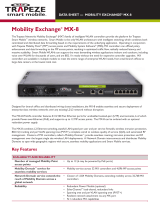 Trapeze Networks MX-8-EU Datasheet
Trapeze Networks MX-8-EU Datasheet
-
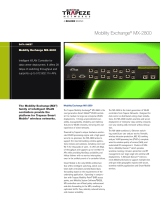 Trapeze Networks MX-2800-EU Datasheet
Trapeze Networks MX-2800-EU Datasheet
-
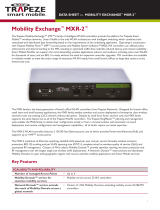 Trapeze Networks MXR-2-EU Datasheet
Trapeze Networks MXR-2-EU Datasheet
-
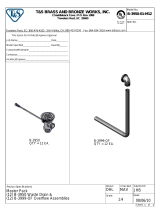 T & S Brass & Bronze Works B-3950-01-M12 Datasheet
T & S Brass & Bronze Works B-3950-01-M12 Datasheet
-
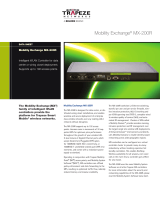 Trapeze Networks MX-200R-EU Datasheet
Trapeze Networks MX-200R-EU Datasheet
-
ASCOM I62 - Troubleshooting Manual
-
ASCOM VOWIFI SYSTEM - System Description
-
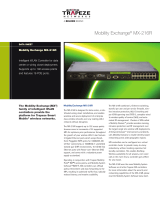 Trapeze Networks MX-216R-EU Datasheet
Trapeze Networks MX-216R-EU Datasheet













